Discover Florida Nature
It's time to explore the natural Florida


|
|
|
|
|
Find Florida plants for your landscape and Florida garden. Learn about
Florida-friendly plants, including Florida native plants, that require
little irrigation or fertilizer, are low maintenance and attract
wildlife. With Florida's plentiful plant life, it is no surprise that we
have some unique, native grasses. 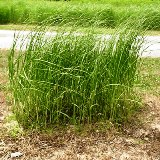 Cordgrass (Spartina
spp.)- Smooth cord grass is a native on the U.S. Atlantic coast, but is
considered to be a non-native invasive plant on the U.S. Pacific coast.
Smooth cord grass is a medium-large saltwater-loving is frequently found
growing in tidal flats, salt marshes, and beaches nearly throughout
Florida. It blooms from summer to fall and occurs almost always
(estimated probability 99%) under natural conditions in wetlands. Its
roots are a favorite food of snow geese. Cordgrass (Spartina
spp.)- Smooth cord grass is a native on the U.S. Atlantic coast, but is
considered to be a non-native invasive plant on the U.S. Pacific coast.
Smooth cord grass is a medium-large saltwater-loving is frequently found
growing in tidal flats, salt marshes, and beaches nearly throughout
Florida. It blooms from summer to fall and occurs almost always
(estimated probability 99%) under natural conditions in wetlands. Its
roots are a favorite food of snow geese.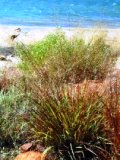 Elliott's
Lovegrass (Eragrostis elliottii)- Elliot's lovegrass is grass
found among flatwoods, sandhills, and prairies from summer through fall.
There are 30 varieties and species of
Eragrostis in Florida. Elliott's lovegrass grows in Pensacola,
Miami and everywhere in between. this plant is drought tolerant and is
suitable for xeriscaping. Elliott's
lovegrass is useful in preventing soil erosion and does well in full sun
to partial shade. Elliott's love grass prefers sandy soil, that is
either wet or dry. Elliott's
Lovegrass (Eragrostis elliottii)- Elliot's lovegrass is grass
found among flatwoods, sandhills, and prairies from summer through fall.
There are 30 varieties and species of
Eragrostis in Florida. Elliott's lovegrass grows in Pensacola,
Miami and everywhere in between. this plant is drought tolerant and is
suitable for xeriscaping. Elliott's
lovegrass is useful in preventing soil erosion and does well in full sun
to partial shade. Elliott's love grass prefers sandy soil, that is
either wet or dry.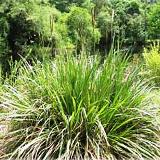 Fakahatchee
Grass (Tripsacum dactyloides and cvs.)- Easy to grow and
virtually pest-free, Fakahatchee Grass is stunningly beautiful with its
rich green foliage erupting from fountain-like clumps that will grow to
5 feet in height and 4 feet wide. The leaves are erect up to 6 feet in
length and about 1 inch wide. Distinctive flowers appear in late spring
to mid-summer and rise above the leaves on slender stems. Gamma grass is
evergreen in sub-tropical areas. When exposed to frosts the leaves
assume shades of red and bronze. Fakahatchee
Grass (Tripsacum dactyloides and cvs.)- Easy to grow and
virtually pest-free, Fakahatchee Grass is stunningly beautiful with its
rich green foliage erupting from fountain-like clumps that will grow to
5 feet in height and 4 feet wide. The leaves are erect up to 6 feet in
length and about 1 inch wide. Distinctive flowers appear in late spring
to mid-summer and rise above the leaves on slender stems. Gamma grass is
evergreen in sub-tropical areas. When exposed to frosts the leaves
assume shades of red and bronze.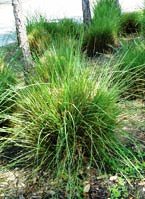 Florida
Gama Grass (Tripsacum floridana) is an accent grass. This
Floridian native grass makes a great groundcover in open, dry areas,
when planted in masses. Florida Gama grass is a wonderful accent in
wildflower and rock gardens. This grass grows to About 2-3 feet in
height; to 4 feet when in flower, and is about as broad as tall. You
will find Florida Gama grass from Monroe, Miami-Dade and Collier
counties and south to the
pine rocklands of
Big Pine Key. Florida
Gama Grass (Tripsacum floridana) is an accent grass. This
Floridian native grass makes a great groundcover in open, dry areas,
when planted in masses. Florida Gama grass is a wonderful accent in
wildflower and rock gardens. This grass grows to About 2-3 feet in
height; to 4 feet when in flower, and is about as broad as tall. You
will find Florida Gama grass from Monroe, Miami-Dade and Collier
counties and south to the
pine rocklands of
Big Pine Key.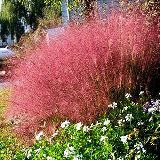 Muhly
Grass (Muhlenbergia capillaris)- This ornamental clumping grass
is native to Texas and Florida and grows 3 feet tall and wide. With the
flower spikes (inflorescence), it is 4 feet tall and 4 feet wide. The
deep pinkish-red inflorescence which are loose and open in appearance
give the tops of the plants a feathery or cotton candy look. They last
up to two months. The inflorescence is quite magnificent when backlit by
early morning or late afternoon sun. Muhly
Grass (Muhlenbergia capillaris)- This ornamental clumping grass
is native to Texas and Florida and grows 3 feet tall and wide. With the
flower spikes (inflorescence), it is 4 feet tall and 4 feet wide. The
deep pinkish-red inflorescence which are loose and open in appearance
give the tops of the plants a feathery or cotton candy look. They last
up to two months. The inflorescence is quite magnificent when backlit by
early morning or late afternoon sun.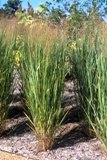 Panic
Grass (Panicum virgatum and cvs.)- This native perennial grass
is tufted at the base, sending out multiple culms that are erect to
spreading and up to 2½' long. The culms are green to reddish green and
terete, branching occasionally to produce side stems. Each node of the
culms has a dense ring of long white hairs; sometimes the culms are
reddish near the nodes. The blades of the alternate leaves are up to 3½"
long and nearly ½" across; they are narrowly lanceolate, green, and
flat. The upper surface of each leaf blade is hairless or sparsely
covered with short white hairs; sometimes there are a few long hairs
near its base. The lower surface of each leaf blade is more or less
hairy. The leaf sheaths are green, longitudinally ribbed, and heavily
covered with long white hairs. Panic
Grass (Panicum virgatum and cvs.)- This native perennial grass
is tufted at the base, sending out multiple culms that are erect to
spreading and up to 2½' long. The culms are green to reddish green and
terete, branching occasionally to produce side stems. Each node of the
culms has a dense ring of long white hairs; sometimes the culms are
reddish near the nodes. The blades of the alternate leaves are up to 3½"
long and nearly ½" across; they are narrowly lanceolate, green, and
flat. The upper surface of each leaf blade is hairless or sparsely
covered with short white hairs; sometimes there are a few long hairs
near its base. The lower surface of each leaf blade is more or less
hairy. The leaf sheaths are green, longitudinally ribbed, and heavily
covered with long white hairs. 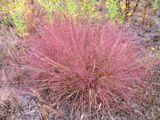 Purple
Lovegrass (Eragrostis spectabilis)- A perennial grass weed with
rhizomes that has a relatively large, open panicle that is purple in
color. Purple lovegrass is primarily a weed of pastures, hayfields, and
noncrop areas and is found throughout the southeastern United States.
Leaf sheaths are round and hairy, especially at the collar region. The
distinctive purple panicle, low-growing habit, rhizomes, and leaves that
have long hairs especially near the collar region are all
characteristics that help to distinguish purple lovegrass from most
other grass weeds. Purple
Lovegrass (Eragrostis spectabilis)- A perennial grass weed with
rhizomes that has a relatively large, open panicle that is purple in
color. Purple lovegrass is primarily a weed of pastures, hayfields, and
noncrop areas and is found throughout the southeastern United States.
Leaf sheaths are round and hairy, especially at the collar region. The
distinctive purple panicle, low-growing habit, rhizomes, and leaves that
have long hairs especially near the collar region are all
characteristics that help to distinguish purple lovegrass from most
other grass weeds.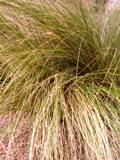 Wiregrass
(Aristida stricta var. beyrichiana)- Wiregrass, also called pineland
threeawn, is one of the most common grasses in the southern pine
flatwoods and upland sandhills. It is a favorite food of gopher
tortoises and quail and provides valuable cover for many birds,
reptiles, and small mammals. The young plants may also be used as a
forage by livestock. Wiregrass is a perennial bunch grass that grows in
dense, spreading tufts, reaching heights of 1½' to 3'. The leaves are
long, thin, wiry, or needle-like with tufts of fine, white fuzz around
the leaf base. Wiregrass
(Aristida stricta var. beyrichiana)- Wiregrass, also called pineland
threeawn, is one of the most common grasses in the southern pine
flatwoods and upland sandhills. It is a favorite food of gopher
tortoises and quail and provides valuable cover for many birds,
reptiles, and small mammals. The young plants may also be used as a
forage by livestock. Wiregrass is a perennial bunch grass that grows in
dense, spreading tufts, reaching heights of 1½' to 3'. The leaves are
long, thin, wiry, or needle-like with tufts of fine, white fuzz around
the leaf base.
|
|
|
Advertise | Privacy Statement | Dog Encyclopedia | Video |Contact | Alaska Nature |
|